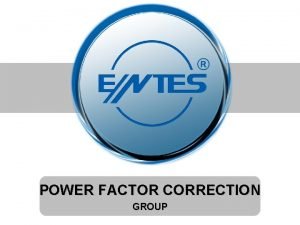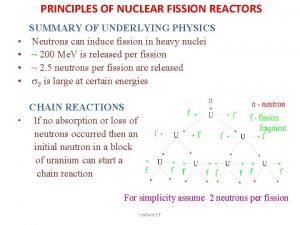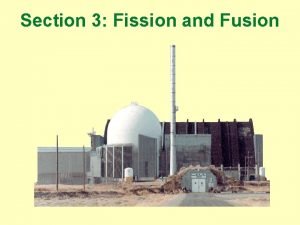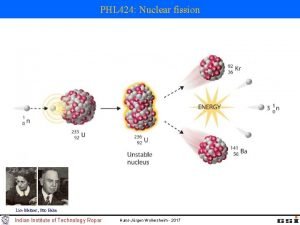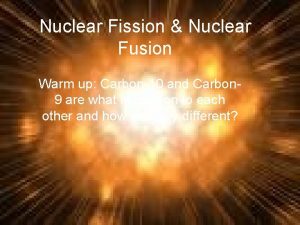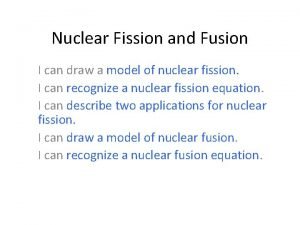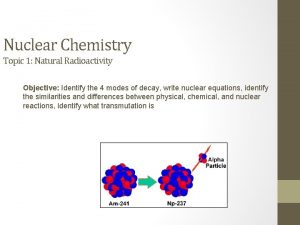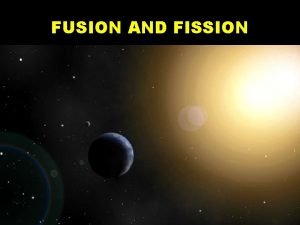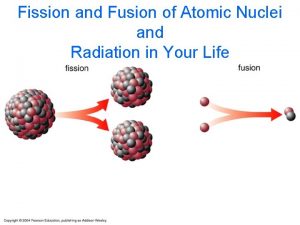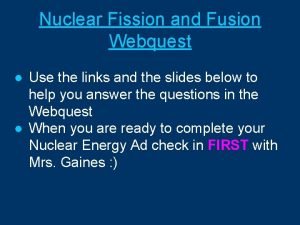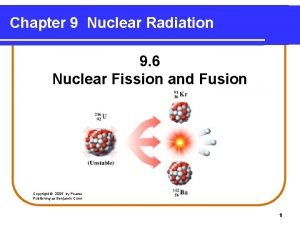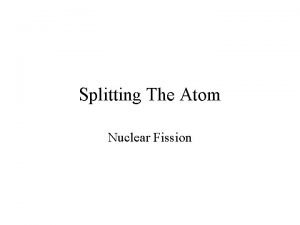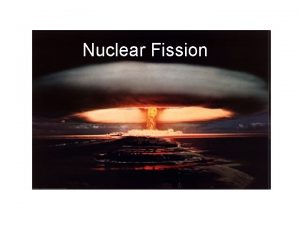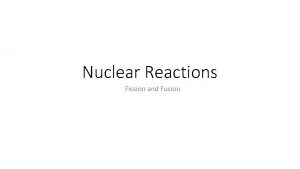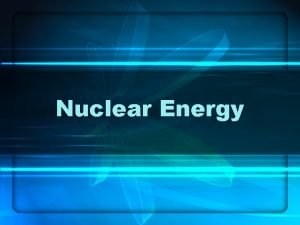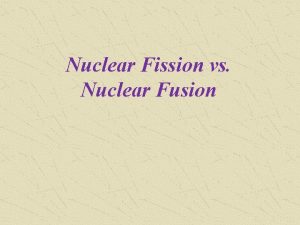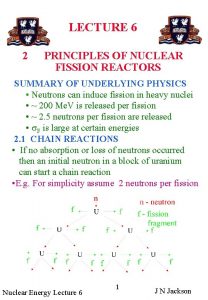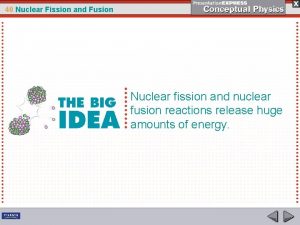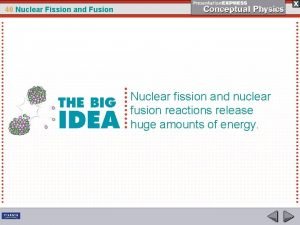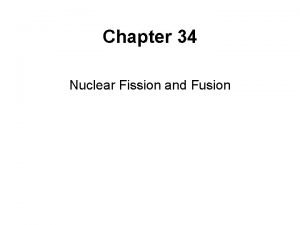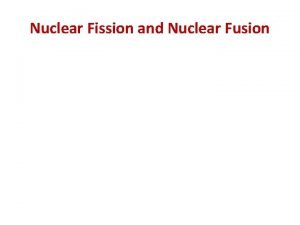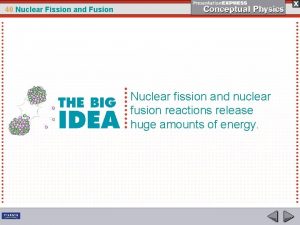PRINCIPLES OF NUCLEAR FISSION REACTORS SUMMARY OF UNDERLYING












- Slides: 12

PRINCIPLES OF NUCLEAR FISSION REACTORS • • SUMMARY OF UNDERLYING PHYSICS Neutrons can induce fission in heavy nuclei ~ 200 Me. V is released per fission ~ 2. 5 neutrons per fission are released s. F is large at certain energies CHAIN REACTIONS • If no absorption or loss of neutrons occurred then an initial neutron in a block of uranium can start a chain reaction For simplicity assume 2 neutrons per fission Lecture 17

Fermi’s Chicago pile number 1 with alternating layers of uranium and graphite. On December 2 nd 1942 Fermi slipped the control rods out of the pile generating heat. Lecture 17 2

• Define REPRODUCTION CONSTANT ( MULTIPLICATION FACTOR) k • k > 1 ‘Super-critical’ – explosion (bomb) • k<1 ‘Sub-critical’ – reaction dies out • k=1 ‘Critical’ – stable chain reaction • Excess reactivity dk = k - 1 • k depends on many factors including the cross sections. Natural Uranium (Infinite system) - No chain reaction possible • As neutrons slow from 2 Me. V to 1 ke. V sc becomes dominant over sf Enriched Uranium (with 235 U) Chain reaction possible • For all values of Tn, sf (235 U) > sc • Shows basis for FAST REACTORS in which mostly high energy neutrons cause fission Lecture 17 3

Conceptual diagram of a basic thermal reactor • A simple matrix of natural (or slightly enriched U surrounded by a moderator – FUEL: U (or less frequently Pu) – MODERATOR: C, H 2 O or D 2 O to slow neutrons from ~2 Mev to < 1 e. V – CLADDING: Contains fuel and prevents release of radioactive fission products + provides thermal contact with coolant – COOLANT Gas or liquid, separated from fuel and moderator. takes heat away from fuel for electricity generation – CONTROL RODS Usually B (or Cd )with large s. C for thermal neutrons to maintain k=1 – SHIELD Usually steel to contain pressure and concrete to give radiation protection Lecture 17 4

Oldbury Magnox reactor 1968 Lecture 17 5

• For n + U s. R is negligible and the other cross sections (barns) as a function of energy are Tn Me. V 2 2 2 0. 3 0. 001 Thermal Isotope 238 U NATU 235 U s. S 4 4 3. 5 9 9 7 11 11 10 8 8 10 sf 0. 6 1. 3 0 0. 009 1. 3 0 0. 6 8 0 4. 1 580 si 2. 9 2. 3 0. 5 0. 7 0 0 0 s. C 0. 2 0 4 4 3 3 3. 7 100 Remember that there are large resonances below 1 ke. V Lecture 17 6

ROLE OF THE MODERATOR • The moderator slows neutrons by elastic scattering – E. g. General case : - • Let the masses of n and X be m and M respectively • In the Laboratory Frame X recoils in this process and so n loses energy in this frame • If we consider the process in the Centre of Mass System where n and X have equal and opposite momenta before and after scattering No loss of energy in this frame Consider the transformation to the centre of Mass system travelling with speed VC Lecture 17 7

• In CMS mu 1 + Mu. X 1= 0 by definition • Also u 1 = u - VC and u. X 1 = - VC Substituting for u 1 and u. X 1 gives VC = u m / (m + M) and u 1 = u M / (m +M) • Now consider the final velocities of the neutron, v and v 1 in lab. and CMS, and v. X 1 the corresponding velocities for X. • In CMS mv 1 + Mv. X 1=0= mu 1 + Mu. X 1 |v 1 | = |u 1 | and |v. X 1 | = |u. X 1 | • The velocity v may be found from the following triangle of velocities using the cosine rule Lecture 17 8

• Substituting for VC and v 1 we obtain • Let T 0 and T 1 represent the neutron K. E. before and after collision so T 0 = ½ m u 2 and T 1 = ½ m v 2 • If A is the mass number of X then M=A u and m= 1 u • The maximum energy loss occurs when cos(q) = -1 with T 1 a minimum – i. e. q =1800 (head-on collision) • Experiment shows that the angular distribution of the neutrons is isotropic in the C. M. S. Lecture 17 9

• N. B. f is the azimuthal angle and the –ve sign occurs because T 1 decreases as q increases • Integrating over f gives : - Lecture 17 10

• For rapid moderation we need A as small as possible – e. g. to reduce Tn from 2 Me. V to 0. 025 e. V takes ~ 20 collisions for hydrogen but ~ 100 for carbon • Practical considerations for choice of moderator are 1) small A, 2) large s. S, and 3) small s. A ( = s. C + s. R) CHOICES H 2 O D 2 O GRAPHITE s. S (b) 50 11 4. 7 s. A (b) 0. 66 0. 001 0. 0045 • N. B. If H 2 O is used then U must be enriched with 235 U because the absorption s. A is large for H 2 O Lecture 17 11

EXAMPLE: Compare the probabilities of traversing 1 m of a) H 2 O, b) D 20 and 3) Graphite without being absorbed. [Densities are: - a)1000 kg m-3, b)1100 kg m-3 and c) 1600 kg m-3] P(x) = exp (-N s x) a) H 2 O; NH 2 O = 1000 / ( 18 * 1. 66 10 -27) = 4. 78 1028 m-3 PH 2 O = exp (- 4. 78 1028 x 0. 66 10 -28) = 0. 043 b) D 2 O; ND 2 O = 1100 / ( 20 * 1. 66 10 -27) = 3. 31 1028 m-3 PD 2 O = exp (- 3. 31 1028 x 0. 001 10 -28) = 0. 997 c) Graphite; NC = 1600 / ( 12 * 1. 66 10 -27) = 8. 03 1028 m-3 PC = exp (- 8. 03 1028 x 0. 0045 10 -28) = 0. 965 Lecture 17 12
 Low voltage three phase choke coil filter reactor in pfc
Low voltage three phase choke coil filter reactor in pfc Nuclear fission explanation
Nuclear fission explanation Nuclear transmutation equation
Nuclear transmutation equation Fission vs fusion
Fission vs fusion Nuclear fission lise meitner
Nuclear fission lise meitner Are nuclear power plants fission or fusion
Are nuclear power plants fission or fusion Nuclear fission drawing
Nuclear fission drawing Fission and fusion similarities
Fission and fusion similarities Sun fusion or fission
Sun fusion or fission Fusion fission
Fusion fission Fission vs fusion
Fission vs fusion Nuclear fusion radiation
Nuclear fusion radiation Nuclear fission
Nuclear fission
